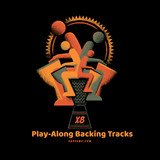The Origins of the Djembe
The djembe is one of West Africa's best known instruments. Traditionally carved from a single piece of wood with an animal skin drumhead, this hand drum belongs to the membranophane class of instruments, and stand generally between twelve and twenty-four inches tall.
The name of the djembe came from the Bamana in Mali, who said "Anke dje, anke be" to call their people together, as the saying translates as "everyone gather together." "Dje" means gather and "be" means everyone, which gave the drum used in these calls to order its name. The Bamanakans' mythology tells of the original djembe, which was made of the hide of a giraffe-zebra hybrid called the gebraffe.
In actuality, the djembe drum is about 700 years old, and was created in Mali by the Malinke people. The territory of Mali almost a millennia ago was made of parts of current Mali, Guinea, Liberia, Senegal, and Burkina Faso, among other African countries.
Blacksmiths made the first djembes, making each drum custom-fitted to the drummer who would play it. The making of the drum was spiritual, and the blacksmith was obliged to make offerings to the spirits of the trees he cut down. Once the blacksmith finished the djembe, it was delivered to the drummer who commissioned it, a member of the djeli caste. The djeli were musicians, who were responsible for the oral history of their people.
The djeli caste still exists today, and is responsible for the traditional music. The djeli sing and perform during rituals, baptisms, weddings and funerals, and are trusted with the music of their ancestors.
During a performance, the djembe begins the ritual, followed by the singer and the other instruments. The djembe player can change the beat of the drums in order to change the song, and the singer and instrument players use the rhythm to recognize what they should be playing. Meanwhile, the guests at the ceremony dance to the rhythm in a circle. Solo dancers will leave the circle to dance for the djembe players.
Hundreds of years later, the djembe gained a new following after West African countries gained independence. Highlighting the old culture of these newly sovereign states, djembe was used in national ballets, and drew emphasis to the djembe as a musical instrument in and of itself, rather than as an accompaniment. Most modern djembe troupes have done away with their dancers altogether, focusing completely on the music being made.
Even as recently as the 1950s, the djembe was not known beyond African music aficionados and those who grew up with the instrument. However, during the midcentury, Fodeba Keita, of Guinea, brought a tour of Les Ballets Africains around the world. The instrument became well known, and more Americans began using the drum in their music.
In today's musical world, the djembe is making its way into the global consciousness. More people than ever listen to world music, popularized greatly by the rapid spread of West African ballets and orchestras especially during the 1980s. Though the instruments are not being made traditionally, they're more accessible than ever, helping a new generation of drummers discover the djembe.
Recent Posts
-
X8 Drums Play-Along Backing Tracks
The new X8 Play-Along Series is being produced for our musician friends wanting a fresh way to work …9th Feb 2025 -
What is the Best Size Djembe for Beginners?
If you're new to the world of percussion and interested in learning the djembe, you're in for a t …16th Jul 2024 -
The Benefits of Becoming a Drumming Teacher: Transforming Passion into Profession
Why become a drumming teacher? Becoming a drumming teacher is an excellent way to share your pas …22nd May 2024



